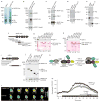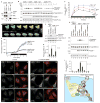AKAP-Lbc enhances cyclic AMP control of the ERK1/2 cascade
- PMID: 21102438
- PMCID: PMC3042953
- DOI: 10.1038/ncb2130
AKAP-Lbc enhances cyclic AMP control of the ERK1/2 cascade
Abstract
Mitogen-activated protein kinase (MAPK) cascades propagate a variety of cellular activities. Processive relay of signals through RAF-MEK-ERK modulates cell growth and proliferation. Signalling through this ERK cascade is frequently amplified in cancers, and drugs such as sorafenib (which is prescribed to treat renal and hepatic carcinomas) and PLX4720 (which targets melanomas) inhibit RAF kinases. Natural factors that influence ERK1/2 signalling include the second messenger cyclic AMP. However, the mechanisms underlying this cascade have been difficult to elucidate. We demonstrate that the A-kinase-anchoring protein AKAP-Lbc and the scaffolding protein kinase suppressor of Ras (KSR-1) form the core of a signalling network that efficiently relay signals from RAF, through MEK, and on to ERK1/2. AKAP-Lbc functions as an enhancer of ERK signalling by securing RAF in the vicinity of MEK1 and synchronizing protein kinase A (PKA)-mediated phosphorylation of Ser 838 on KSR-1. This offers mechanistic insight into cAMP-responsive control of ERK signalling events.
Conflict of interest statement
The authors declare no competing financial interests.
Figures





Similar articles
-
Reciprocal regulation of PKA and Rac signaling.Proc Natl Acad Sci U S A. 2013 May 21;110(21):8531-6. doi: 10.1073/pnas.1215902110. Epub 2013 May 8. Proc Natl Acad Sci U S A. 2013. PMID: 23657011 Free PMC article.
-
Plugging PKA into ERK scaffolds.Cell Cycle. 2011 Mar 1;10(5):731-2. doi: 10.4161/cc.10.5.14902. Epub 2011 Mar 1. Cell Cycle. 2011. PMID: 21311231 Free PMC article.
-
cAMP inhibits the proliferation of retinal pigmented epithelial cells through the inhibition of ERK1/2 in a PKA-independent manner.Oncogene. 2002 Sep 5;21(39):6101-12. doi: 10.1038/sj.onc.1205765. Oncogene. 2002. PMID: 12203122
-
Untying the regulation of the Raf-1 kinase.Arch Biochem Biophys. 2002 Aug 1;404(1):3-9. doi: 10.1016/s0003-9861(02)00244-8. Arch Biochem Biophys. 2002. PMID: 12127063 Review.
-
AKAP-Lbc: a molecular scaffold for the integration of cyclic AMP and Rho transduction pathways.Eur J Cell Biol. 2006 Jul;85(7):603-10. doi: 10.1016/j.ejcb.2006.01.001. Epub 2006 Feb 7. Eur J Cell Biol. 2006. PMID: 16460837 Review.
Cited by
-
UCR1C is a novel activator of phosphodiesterase 4 (PDE4) long isoforms and attenuates cardiomyocyte hypertrophy.Cell Signal. 2015 May;27(5):908-22. doi: 10.1016/j.cellsig.2015.02.003. Epub 2015 Feb 12. Cell Signal. 2015. PMID: 25683917 Free PMC article.
-
The MLL recombinome of acute leukemias in 2013.Leukemia. 2013 Nov;27(11):2165-76. doi: 10.1038/leu.2013.135. Epub 2013 Apr 30. Leukemia. 2013. PMID: 23628958 Free PMC article.
-
KRAS mutation: from undruggable to druggable in cancer.Signal Transduct Target Ther. 2021 Nov 15;6(1):386. doi: 10.1038/s41392-021-00780-4. Signal Transduct Target Ther. 2021. PMID: 34776511 Free PMC article. Review.
-
The crystal structure of the RhoA-AKAP-Lbc DH-PH domain complex.Biochem J. 2014 Dec 1;464(2):231-9. doi: 10.1042/BJ20140606. Biochem J. 2014. PMID: 25186459 Free PMC article.
-
Analysis of RAS and drug induced homo- and heterodimerization of RAF and KSR1 proteins in living cells using split Nanoluc luciferase.Cell Commun Signal. 2023 Jun 14;21(1):136. doi: 10.1186/s12964-023-01146-9. Cell Commun Signal. 2023. PMID: 37316874 Free PMC article.
References
-
- Raman M, Chen W, Cobb MH. Differential regulation and properties of MAPKs. Oncogene. 2007;26:3100–3112. - PubMed
-
- Mansour SJ, et al. Transformation of mammalian cells by constitutively active MAP kinase kinase. Science. 1994;265:966–970. - PubMed
-
- Wan PT, et al. Mechanism of activation of the RAF-ERK signaling pathway by oncogenic mutations of B-RAF. Cell. 2004;116:855–867. - PubMed
-
- Wilhelm SM, et al. Preclinical overview of sorafenib, a multikinase inhibitor that targets both Raf and VEGF and PDGF receptor tyrosine kinase signaling. Mol Cancer Ther. 2008;7:3129–3140. - PubMed
Publication types
MeSH terms
Substances
Grants and funding
LinkOut - more resources
Full Text Sources
Other Literature Sources
Medical
Molecular Biology Databases
Research Materials
Miscellaneous

